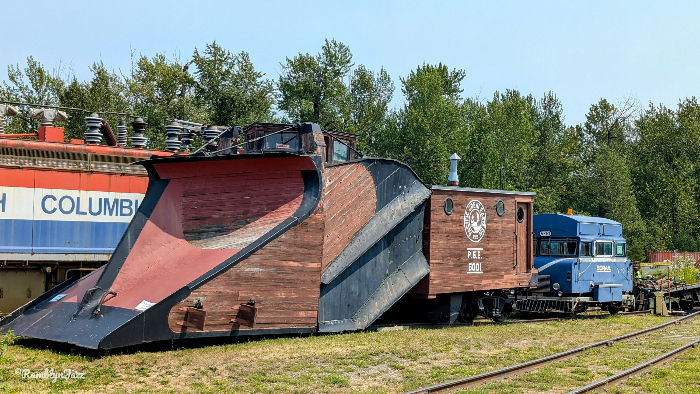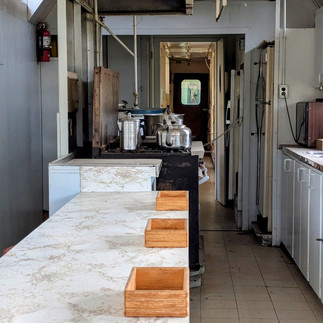More Than Just Tracks: Why You Should Visit Prince George's Railway Museum
- Lyn (aka Jazz)
- Oct 7, 2024
- 5 min read
Have you ever found yourself wandering into a local museum only to be met with dusty exhibits and a lacklustre atmosphere? Well, let me tell you, the Central BC Railway and Forestry Museum in Prince George is a refreshing exception. This local museum far exceeded my expectations and left me wanting to explore more.
Whether you're a history buff, a train enthusiast, or simply looking for a unique, family-friendly activity, this museum is a must-visit. From vintage locomotives to interactive exhibits, there's something for everyone to enjoy. So, if you find yourself in Prince George, add this museum to your itinerary. You won't be disappointed!

Table of Contents
Prince George, British Columbia
I was heading further north on my summer road trip than on previous trips. My route took me to Prince George, where I would pick up supplies and meet an Austrian friend who would travel with me for a couple of weeks of van life exploration. As the largest city in northern British Columbia, it is a regional hub for commerce, healthcare, education, and government services. It is the gateway to the vast and remote northern regions of British Columbia, attracting visitors interested in exploring the wilderness, wildlife, and Indigenous culture.
Indigenous peoples have inhabited the area for thousands of years. The Lheidli T'enneh (clayt-clay den-ay) First Nation is the largest First Nation in the region and has a long history. European exploration and settlement began in the 19th century, primarily driven by the fur trade. Fort George, established in 1807 by the North West Company, was an important regional trading post. Prince George's strategic location in a resource-rich region made it a forestry and resource industries hub. Logging, mining, and other related activities became the driving forces of the city's economy.

The total driving distance from Vancouver to Prince George is approximately 750 kilometres (466 miles). The drive time can vary depending on traffic and road conditions, but it typically takes 8-9 hours. There are regular flights into Prince George from all the major airports in British Columbia (Vancouver, Kamloops, and Victoria). My friend would soon be arriving on a flight from Vancouver Airport, but I had a couple of days before she arrived to explore the area.

I had been on the road for almost six weeks following a route that had taken me through National Parks, including Kootenay, Mount Revelstoke, Banff, Rocky Mountain House, and Jasper, as well as many great provincial parks, such as Mount Robson, Wells Gray, Steelhead, and Chun T'oh Whudujut (click links for posts about each). I then took the Cariboo Gold Rush Trail to Quesnel and arrived in Prince George.
Prince George Railway Museum
The Museum is located on River Road next to Cottonwood Island Nature Park, where I thought I would spend most of my day walking the trails and looking for the 14 bark carvings by local resident Elmer Gunderson. Spoiler -- I only found six and will need to return to find the rest!

My expectations for the Central BC Railway and Forestry Museum were low. I like trains, but I can't consider myself a railway buff. I expected to spend about an hour exploring. I was very wrong. The site is very large and crammed with exhibits.

This museum is a fascinating destination that showcases the rich history of the region's railway and forestry industries. It offers an extensive collection of industrial equipment, artifacts, and historical documents. I spent almost four hours exploring and photographing the fascinating exhibits.

The museum is closed on Mondays and Tuesdays but is open from 11:00 - 16:00 the rest of the week. Adult admission is $10.00 ($9.00 for seniors/students), and there is an additional $4.00 fee for riding the minirail. Guided tours are also available for an additional fee. I chose to explore on my own.

Exhibits of the Central BC Railway and Forestry Museum
The grounds include a large collection of rolling stock from vintage steam locomotives to modern diesel engines, while the museum includes a range of historical rail equipment.

Some trains allow visitors to walk through them, while others require visitors to peek inside through the windows and doors. I appreciated the interactive exhibits that let me get close and engage with hands-on displays.
Visitors can expect to see fancy first-class and regular coach-class carriages, cabooses, as well as steam and diesel trains used to clear snow or transport cargo.

I was delighted by the urban garden. Fruit trees and bushes have been planted around the property to demonstrate sustainability and the variety of food that can be grown in the area.
Historical and modern tools and machinery used in the logging and timber industry are scattered around the grounds. I was surprised by their huge collection of chainsaws. I had no idea that there was such a variety and evolution!
In addition to the railway and forestry buildings, you'll also find a gas station, firehall, merchant buildings, and a collection of vintage vehicles.

I most enjoyed the preserved historical buildings, which included railway stations, workshops, and various other buildings once used in the region. Interpretive signage provides interesting information and stories that bring history to life.

Beehive Burners were a common sight at sawmills. They were used to deal with the massive amounts of debris and by-products that result from milling operations. Before these burners were used, the debris was burned in huge open pits, which were dangerous to humans and the surrounding forests. These beehive burners were considered much safer, but the air quality in the area suffered greatly, becoming choked with ash and smoke. After the enactment of new environmental laws, most beehive burners have been abandoned. Any burners remaining must get a permit from the government and be regularly inspected.

Throughout the year, the museum hosts special events, including family days, holiday celebrations, and educational workshops. I encourage you to check their website for possible events while planning your visit.
Final Thoughts
Whether you are a history buff, a train enthusiast, or simply looking for a unique and educational experience, the Central BC Railway and Forestry Museum is a must-visit destination.
If you are enjoying the content and would like to be kept up to date with new posts become a member/subscribe (it's free!) and follow along on the RamblynJazz Facebook page, Facebook Group, Twitter, and Instagram. You can help the blog to grow by sharing the link with a travelling friend or through social media. I truly appreciate your comments and encourage you to share your thoughts below.
Interested in purchasing photos? Contact me for high-resolution images.
















For those of us who are absolutely fascinated by trains, I am sure that this would be a memorable experience.
Being able to visit the carriages and get a feel for what it was like to travel in them is fantastic.
Without a doubt, a different, educational and immersive experience. Angela | Blonde Around The World Travel -
I gotta say I am also not too enthusiastic about a train museum, but then hearing that you spent 4h in there gives me hope. It makes a huge difference when there are exhibits which visitors can engage with and are also encouraged to do so, rather than just stand behind a line and read information plates. It helps that the railway museum is located within a parkland which is equally interesting for exploring and can engage one's senses anew and keep the engagement alive.
Carolin | <a href="https://solotravelstory.com/">Solo Travel Story</a>
I would also be interested in some of the heritage buildings but I do like a good train so this museum seems perfect for me. I haven't been as far north as Prince George but I might have to go now. The museum seems like a great place to explore. The only other railway museum I've been to is the one in Squamish. As an aside I really liked those carvings, a fun side activity to try and find them all
I agree that sometimes, the railway museums can be lacking. Not all museums are cut from the same cloth, so it's good to see that this one certainly wasn't. I would definitely walk through and analyze the train cars, as i'm fascinated with how the old trains functioned. I would also be mesmerized by the minitrain. It's also good to see the preserved buildings, as that is absolutely part of railway history that sometimes gets forgotten or torn down. Living in New England, we have a lot of old railroad stations that have been repurposed as restaurants and breweries, and i'm all for that too but preserving history is so important - even if it's repurposed for modern use.
www.redsolotraveler.com
I love how you've captured the charm of Prince George's Railway Museum! Being able to step into the older carriages and see the evolution of train travel must be such a great way to understand the history. If I ever find myself in Prince George - I will surely keep this as a thing to do.